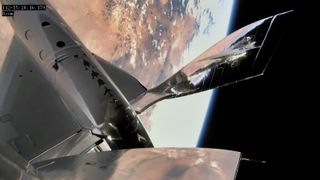Virgin Galactic has launched its first human spaceflight from its New Mexico home port.
The company's SpaceShipTwo vehicle VSS Unity conducted its third crewed test flight to suborbital space today (May 22), taking another step toward the start of commercial operations.
Unity's first two spaceflights occurred in December 2018 and February 2019. Both of those missions lifted off from the Mojave Air and Space Port in southeastern California, near the headquarters of Virgin Galactic's manufacturing subsidiary, The Spaceship Company.
But today's flight took off from Virgin Galactic's commercial hub, Spaceport America in New Mexico. It was the first human spaceflight ever to depart from the Land of Enchantment, and Virgin Galactic marked the milestone by emblazoning the state's famous Zia sun symbol on Unity's exterior and putting some green chile seeds aboard the space plane, company representatives said.
Related: How Virgin Galactic's SpaceShipTwo works (infographic)

And Virgin Group founder Richard Branson was on hand to witness the historic event.
"Delighted to be on the flightline to watch Virgin Galactic's first human spaceflight from the majestic Spaceport America," Branson wrote on Twitter as he shared a video of himself watching the launch.
Get the Space.com Newsletter
Breaking space news, the latest updates on rocket launches, skywatching events and more!
Unity lifted off beneath the wing of its carrier plane, VMS Eve, today around 10:35 a.m. EDT (1435 GMT; 8:35 a.m. local time in New Mexico). About 50 minutes later, at an altitude of 44,000 feet (13,411 meters), Eve dropped Unity, which then fired up its onboard rocket motor and powered itself to suborbital space.
@virgingalactic #UNITY21 pic.twitter.com/c6k4A3H89IMay 22, 2021
The spacecraft reached Mach 3 (three times the speed of sound) and attained a maximum altitude of 55.45 miles (89.2 kilometers) before beginning the trip back down to Earth, Virgin Galactic representatives wrote in a postflight update Saturday. (Where space actually begins is a matter of some debate. Some people recognize the "Karman Line" at 62 miles, or 100 km, as the boundary. But NASA and Air Force personnel get their astronaut wings if they get at least 50 miles, or 80 km, above Earth.)
Pilots C.J. Sturckow and Dave Mackay brought the space plane down for a runway landing at about 11:45 a.m. EDT (1545 GMT; 10:45 a.m. local time), wrapping up the suborbital flight. No other people were aboard the six-passenger Unity today, though the vehicle did carry some scientific payloads as part of NASA's Flight Opportunities program.
Unity had tried once before to perform spaceflight number three. That attempt, on Dec. 12, 2020, ended prematurely after the space plane's motor failed to fire properly. Virgin Galactic traced the problem to electromagnetic interference, which caused a reboot of Unity's onboard computer at the beginning of the ignition sequence. Implementation and validation of the required fix took time, pushing the second attempt back considerably.
Unity is in the final stages of its test campaign, but it's not yet ready to carry paying customers. The space plane will likely conduct several more test flights. If those go well, commercial operations could begin in early 2022, Virgin Galactic representatives said recently.
That schedule would put Virgin Galactic behind its chief competitor in the suborbital space tourism business, Jeff Bezos' Blue Origin. Blue Origin is auctioning off a seat for the first crewed spaceflight of its six-passenger New Shepard vehicle, which is targeted for July 20. It's safe to say that New Shepard's first customer will be wealthy; the auction was up to $2.8 million as of Friday afternoon (May 21).
It's unclear how much Blue Origin will normally charge for a seat on New Shepard, which, unlike SpaceShipTwo, is designed to fly autonomously. More than 600 people have booked a ride on SpaceShipTwo, at a price (most recently) of $250,000 per seat.
While Virgin Galactic's SpaceShipTwo Unity is the first space plane to launch humans into space from New Mexico, it's not actually the first one to land in the state. In 1982, NASA's space shuttle Columbia landed at White Sands Space Harbor to end the STS-3 mission, returning NASA astronauts Jack Lousma and Gordon Fullerton to Earth after an eight-day test flight, the third spaceflight for the shuttle program.
Editor's note: This story was updated at 1:30 p.m. EDT on May 22 to add more details about the flight.
Mike Wall is the author of "Out There" (Grand Central Publishing, 2018; illustrated by Karl Tate), a book about the search for alien life. Follow him on Twitter @michaeldwall. Follow us on Twitter @Spacedotcom or Facebook.
Join our Space Forums to keep talking space on the latest missions, night sky and more! And if you have a news tip, correction or comment, let us know at: community@space.com.

Michael Wall is a Senior Space Writer with Space.com and joined the team in 2010. He primarily covers exoplanets, spaceflight and military space, but has been known to dabble in the space art beat. His book about the search for alien life, "Out There," was published on Nov. 13, 2018. Before becoming a science writer, Michael worked as a herpetologist and wildlife biologist. He has a Ph.D. in evolutionary biology from the University of Sydney, Australia, a bachelor's degree from the University of Arizona, and a graduate certificate in science writing from the University of California, Santa Cruz. To find out what his latest project is, you can follow Michael on Twitter.
